TABLE OF CONTENTS
Conformation faults in horses
In the following list are a number of common conformation faults found in horses and deviations from the “ideal” horse. All horses have some conformation faults, and judging conformation involves evaluating which horse has fewer and less important ones, or which horse is more correct than the others in its class.
Conformation faults of Head
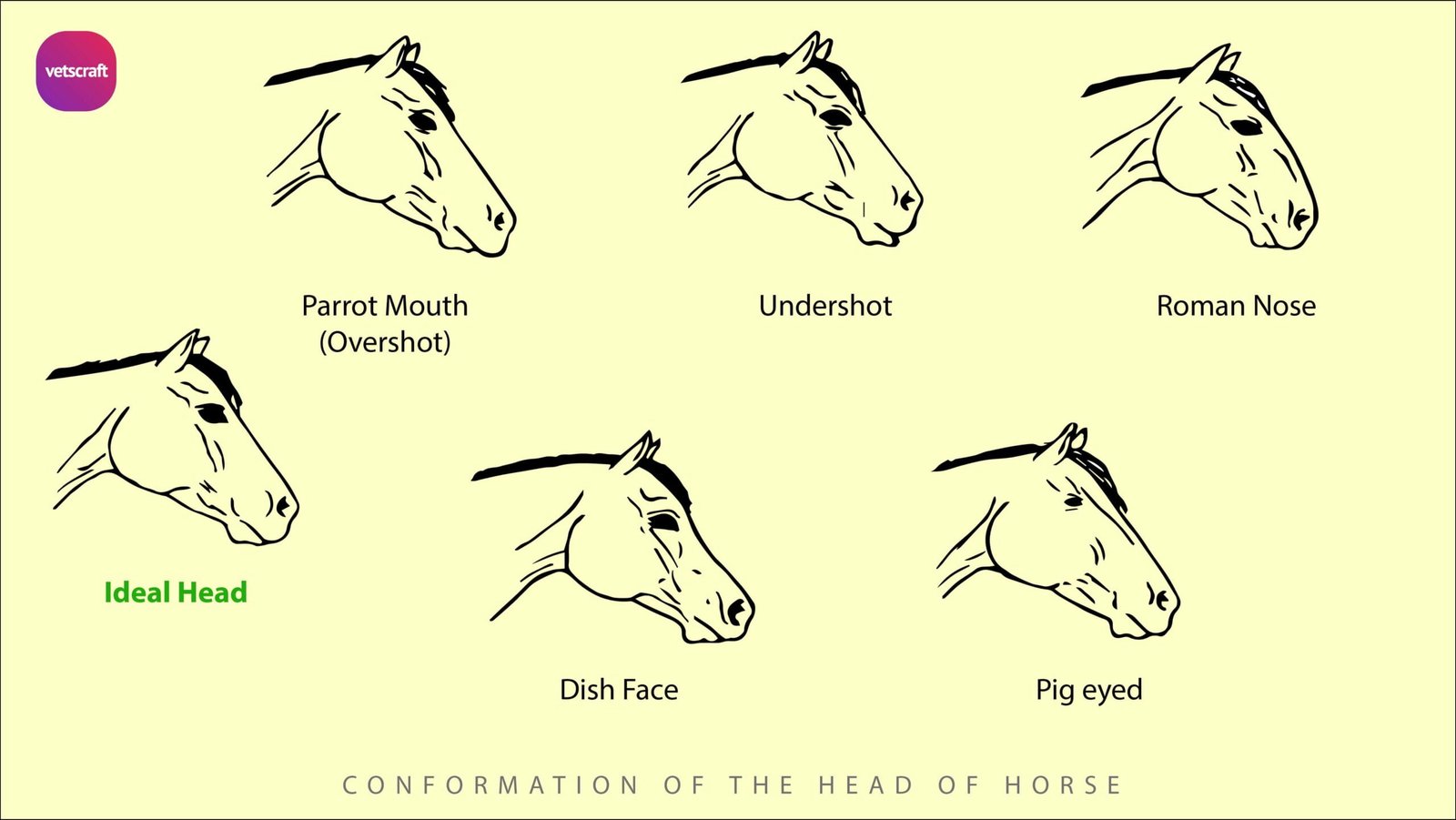
Roman Nose
The bridge of the nose has a rounded or convex shape when viewed from the side. This conformation fault restricts the horse’s frontal vision.
Pig Eye
Small eyes which are set too far back into the head. This conformation fault restricts vision, especially to the rear, as a result the horse often has a nervous or unruly disposition.
Conformation faults of Neck
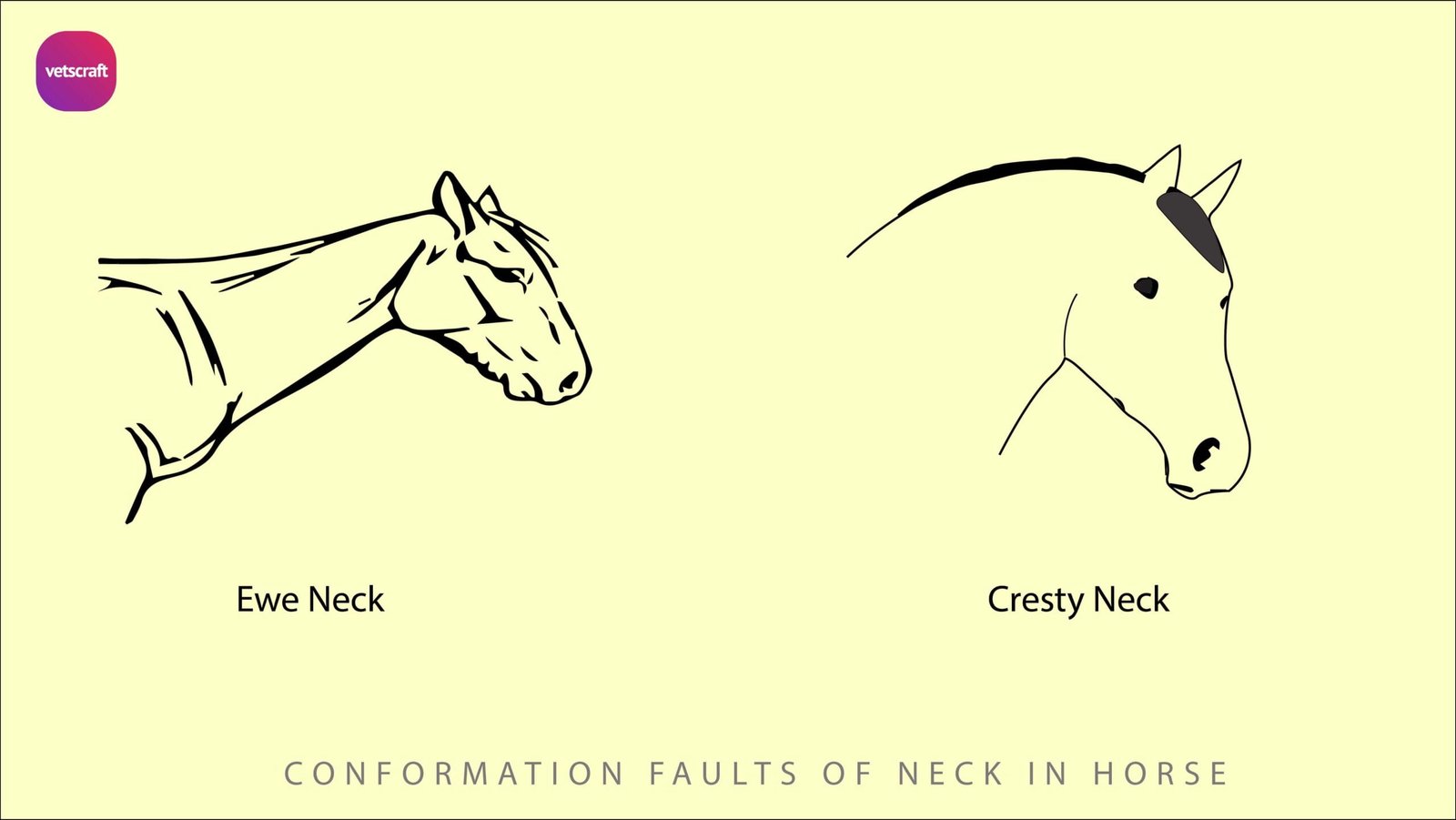
Ewe Neck
Ewe neck appears to be “turned over”. This conformation fault restricts flexion at the poll.
Cresty Neck
Cresty Neck is the excess fat deposits on the crest of the neck. This fault may be a sign of a horse that will founder easily. A cresty neck reduces flexibility and suppleness.
Conformation faults of Shoulder
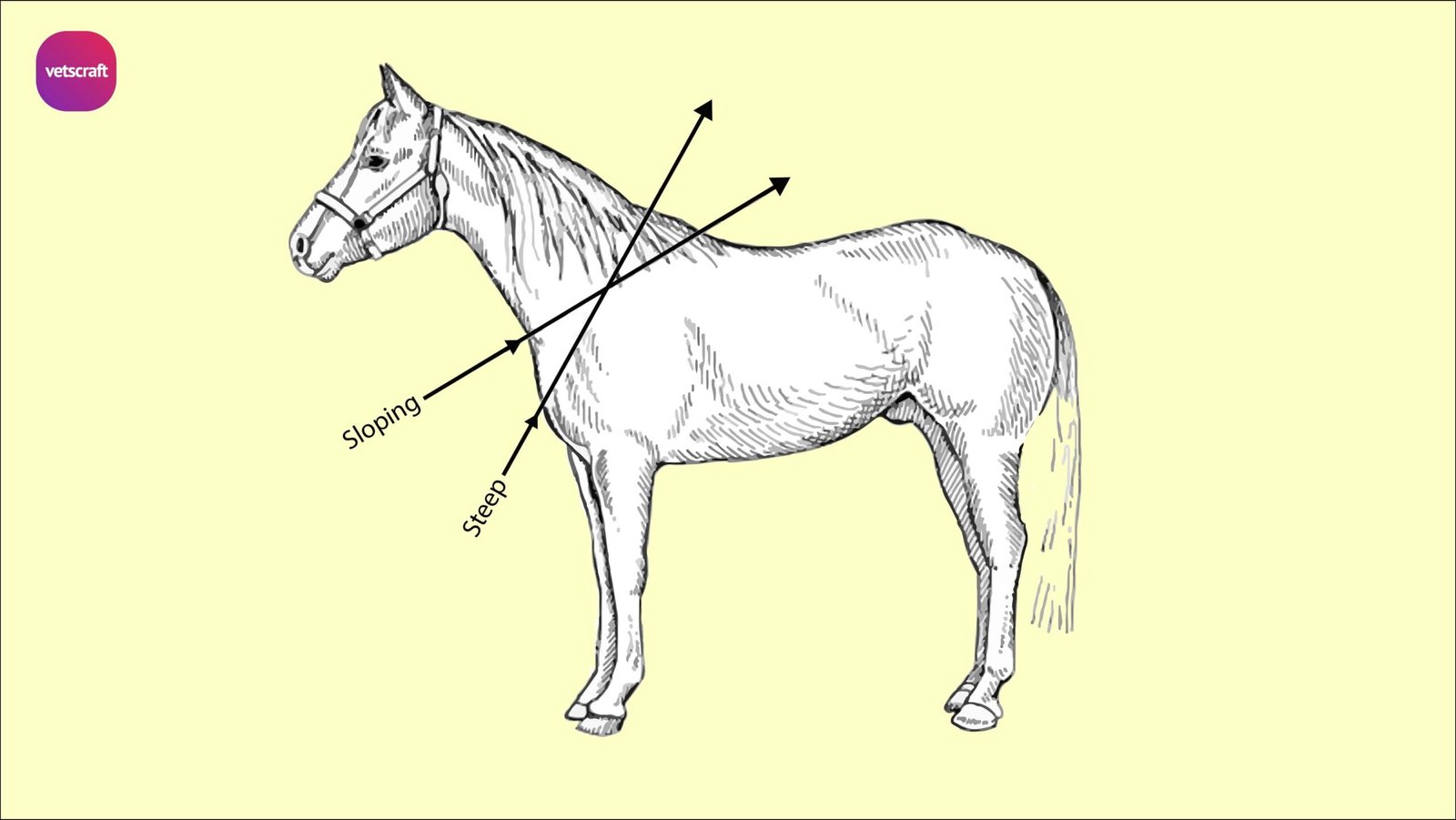
Steep Shoulder
Shoulder angle steeper than 50 degrees. This decreases the length of stride in a horse and makes them rough to ride. It also increases concussion on the forelegs.
Conformation faults of Chest
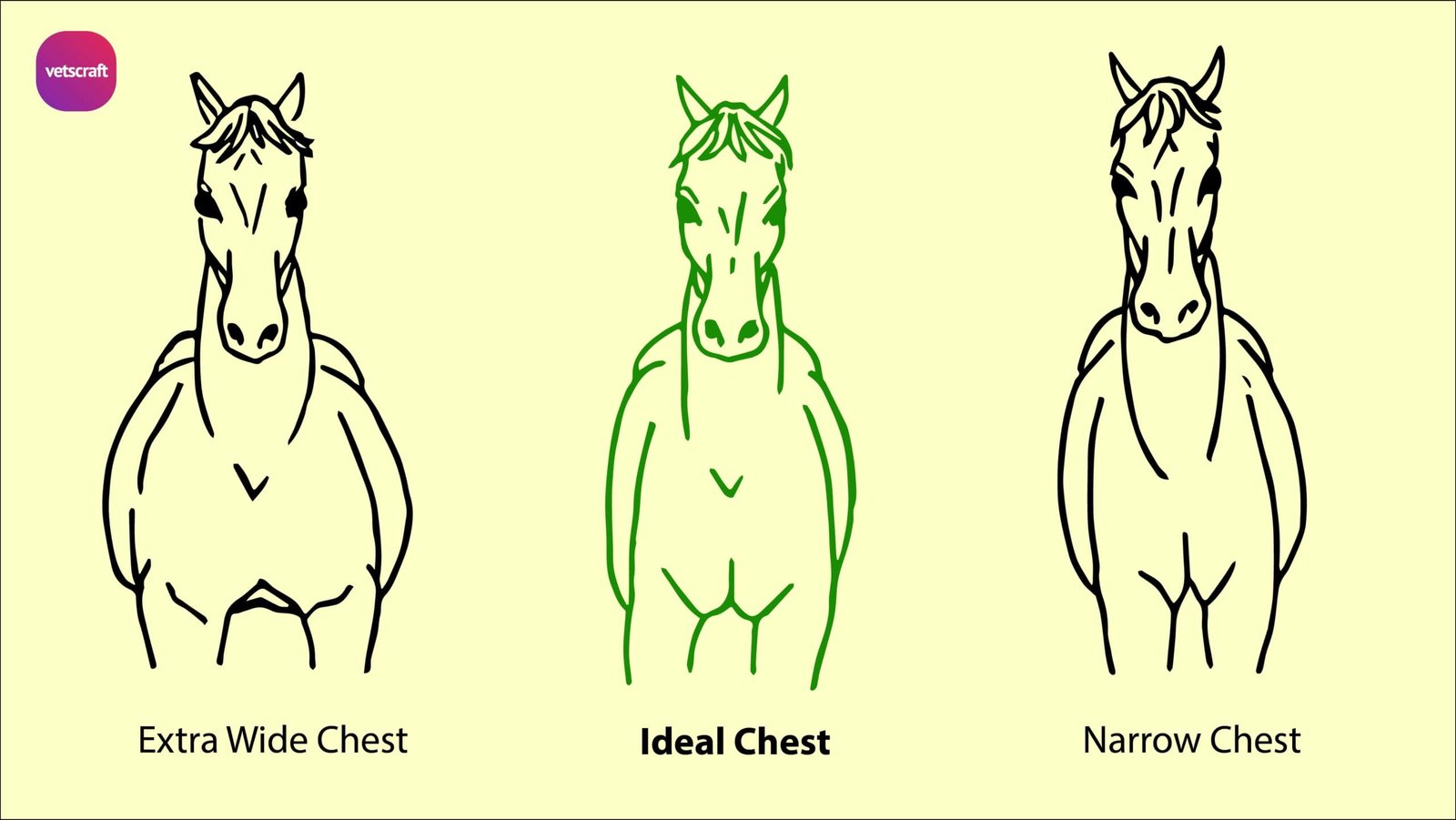
Narrow Chest
In Narrow Chest in horses, legs are too close together and legs may interfere when horse travels.
Extra wide Chest
In Extra wide Chest in horses, legs set too far apart. This produces a labouring, waddling stride and lack of flexibility. Therefore, it reduces the horse’s athletic ability.
Conformation faults of topline
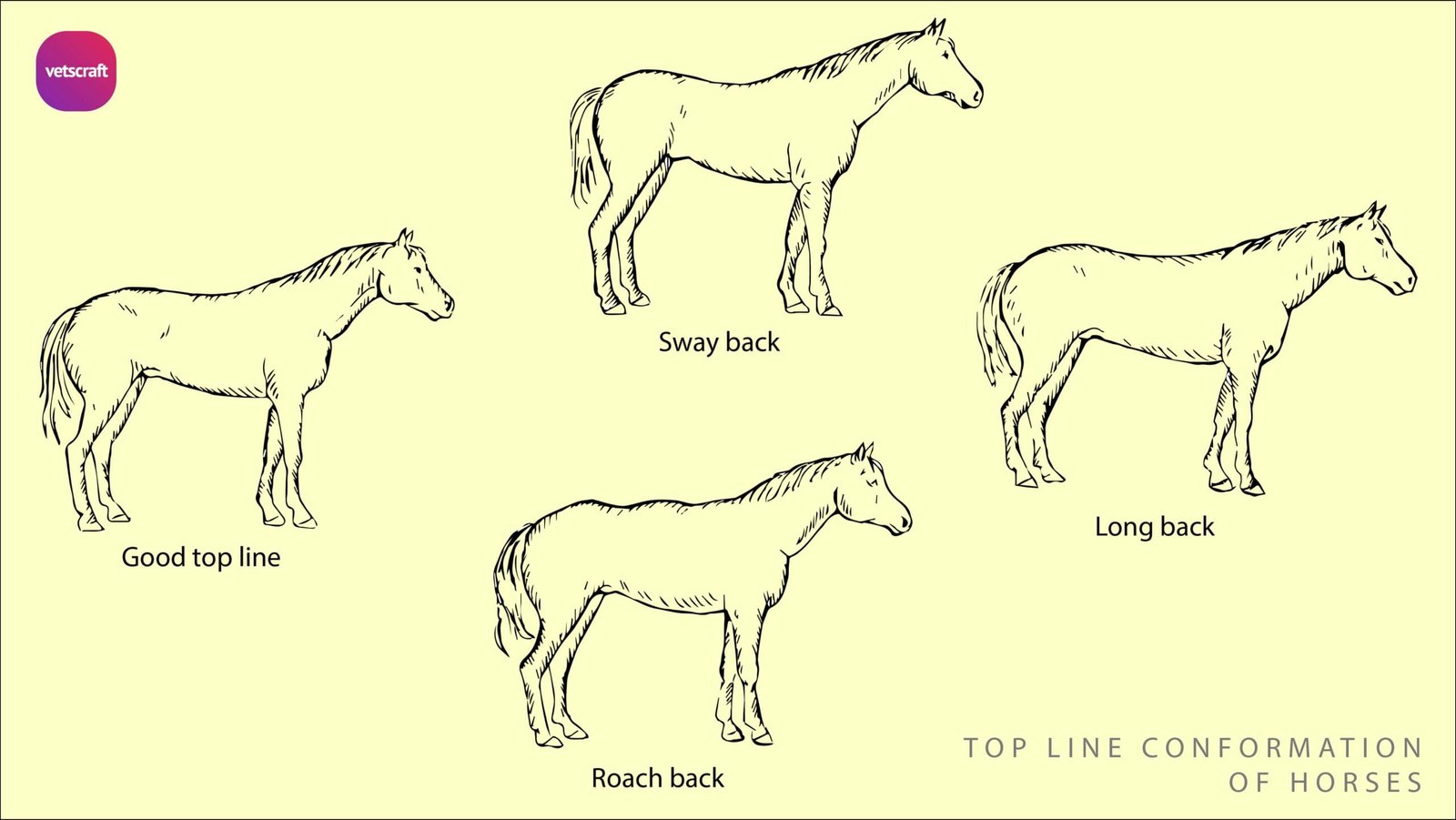
Mutton withers
Mutton withers is the low, wide withers. It is hard to keep the saddle in place without the girth (cinch) being too tight and the saddle is prone to slip to the side.
Sway back
Sway back is the weak topline. This is usually seen in older horses and in horses with long backs and, or loins. This restricts the horses ability to pull legs forward beneath the hindquarters.
Roach back
Loin has a rounded (convex) appearance when viewed from the side. This can restrict flexibility.
Conformation faults of hip and croup
Goose Rump
The rump slopes sharply from the croup to the dock when viewed from the side. This decreases the length of stride.
Rafter Hip
When viewed from the rear, the width at the point of the hip is greater than the width at the stifle. It indicates a lack of muscular development.
Conformation faults of heartgirth & flank
Shallow heartgirth
Depth from withers to elbow is less than the length from elbow to fetlock. This restricts the capacity for heart and lungs and may decrease the endurance of the horse.
Shallow flank
Pronounced narrowing in the flank region. This decreases capacity of the digestive system and decreases the foal carrying capacity in mares.
Conformation faults of feet & legs
Front leg defects
Front leg defects when viewing from the side, the string or stick, would hang so that it divides the knee, cannon and fetlock, and hits the ground at the bulb of the heel-
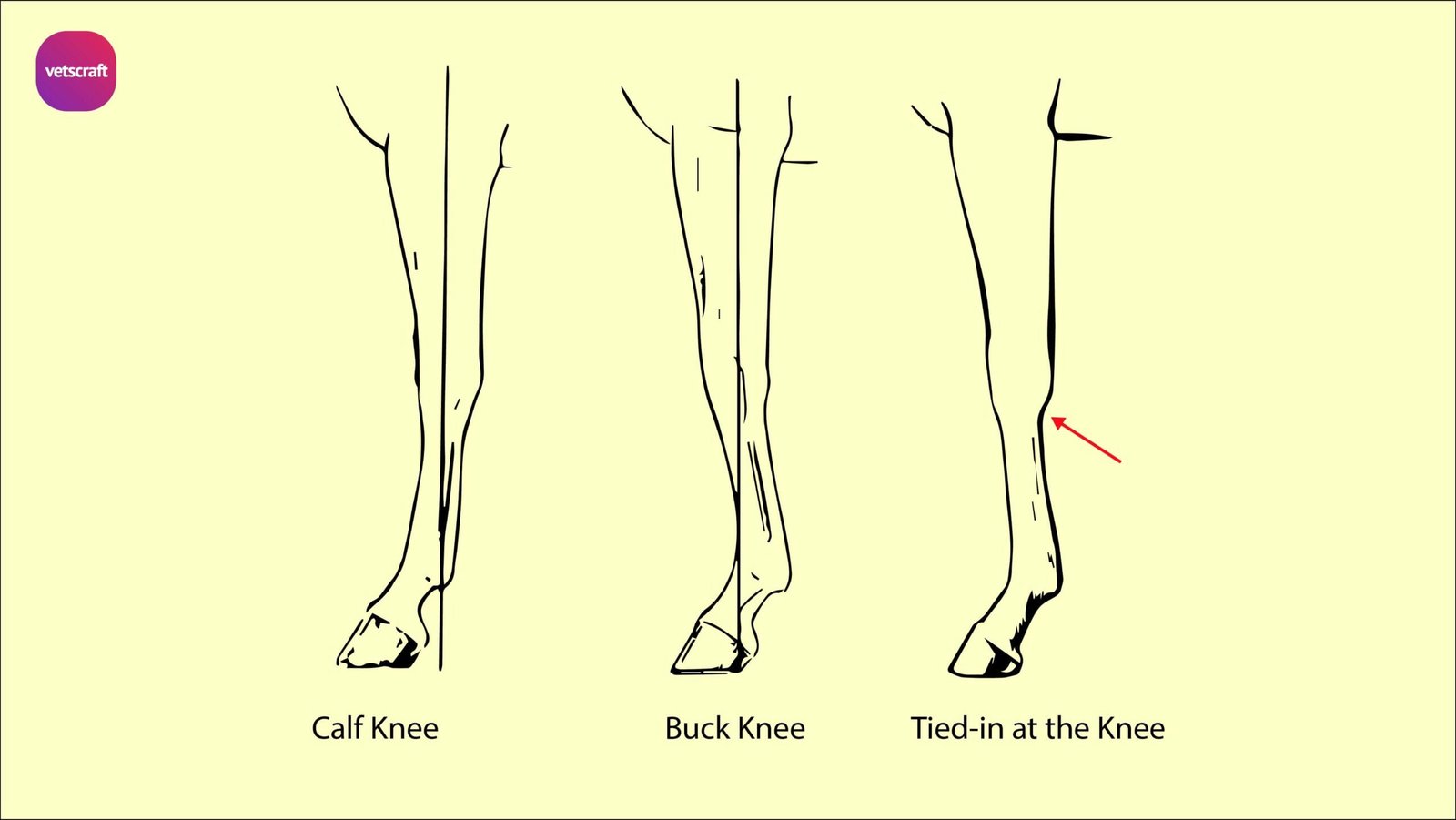
Buck Knees (Over at the Knee)
The knee is forward of a line that bisects (divides in half) the foreleg. This horse may be susceptible to bowed tendons.
Calf Knees (Back at the Knee)
The knee is behind a line that bisects the foreleg. This places excess stress on the front of the knee and strain on the tendons. This horse will be susceptible to chip fractures of the knee and bowed tendons. Calf knees are more serious than buck knees.
Tied-in the Knee
Small, narrow tendons look as if they are squeezed in just below the knee. The leg appears narrower at the base of the knee than at the fetlock, when viewed from the side.
Front leg defects when viewing from the Front, the string or stick would hang so that it bisects the knees, cannons, pasterns and hooves-

KNOCK KNEES
The knees lie inside parallel lines bisecting the forelegs. This places excess stress on the outer knee and strain on the inside ligaments of the forelegs.
BOWLEGS
The knees lie outside parallel lines bisecting the forelegs. This places excess stress on the inner knee and strains on the outside ligaments of the forelegs.
BENCH KNEES
The cannon bone is offset to the outside of the knee. This places more stress on the inside splint bones and the horse will be more susceptible to splints or knee chips.
Hind leg defects
Viewing from the side, a “string” dropped from the point of the buttocks, should run down the back of the hock, cannon and fetlock. It should hit the ground about ½ a hoof’s distance behind the bulb of the heel-
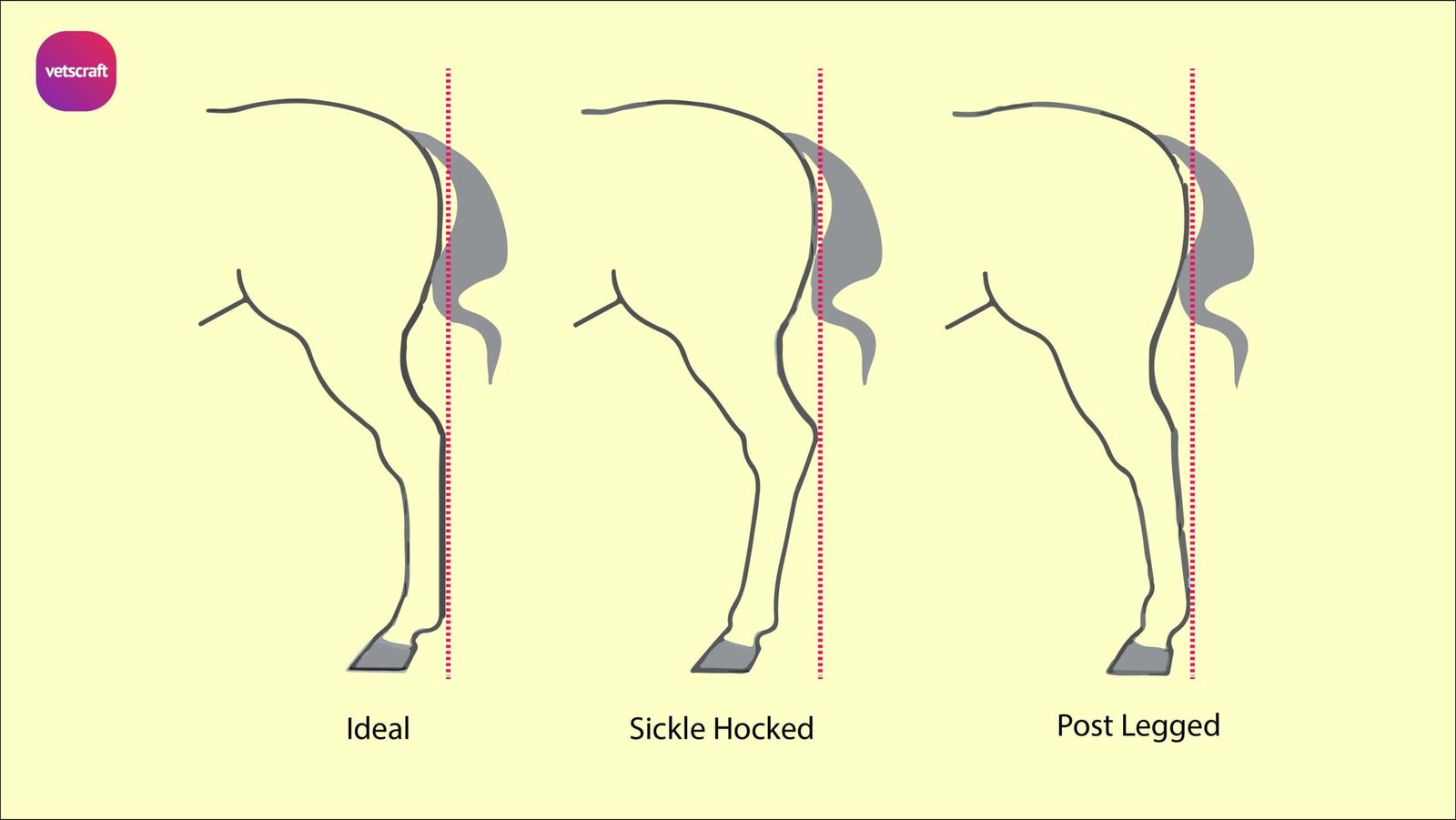
SICKLE HOCKS
Excessive angulation of the hock joint. The horse appears to be standing under from the hock down. This places excess strain on the plantar ligament and the horse will be susceptible to curbs.
POST-LEGGED
Insufficient angulation of the hock joint and stifle. The entire leg appears too straight and the hind leg is set ahead of a line dropped from the point of the buttock. The pasterns are usually also too upright. This places excess stress on the front of the hock joint and on the stifle joint. A horse will be susceptible to bog spavins, thorough pins, bone spavins or stifling.
Viewing from the rear, the “string” would still hang from the point of the buttocks. Ideally, it should run through the middle of the gaskin, hock, cannon bone and fetlock. It should hit the ground between the bulbs of the heel-
COW HOCKS
The hocks are closer together than the fetlocks when standing. They point toward one another, causing the feet to be widely separated and often pointing outward. This hindleg defect places excess stress on the hock joint and strain on the ligaments. This horse is susceptible to bone spavins, curbs or thorough pins.
BOWED HOCKS
Bowed hocks also called “Out at the hocks” or Bandy-legged. The hocks lie outside parallel lines bisecting the hind legs. This may cause interference because horse moves narrower at the ground than at the hock and places excess stress on the hock joint and strain on the ligaments. This horse will be predisposed to bog spavins, curbs or thorough pins.
Front and Hind leg defects
Viewing from the side, the front and rear legs must also be evaluated for how they are positioned under the body of the horse. They should come under the horse’s body so that they stand square and strong, as the ideal pictures show. With a picture of ideal legs, it is then easier to evaluate legs for the following defects-
STANDING UNDER
Front leg- the entire foreleg from the elbow down is too far under the body. This places excess weight on the forelegs.
Rear leg- the entire hindleg is placed too far forward under the body. The horse may also be sickle-hocked or post-legged; stress is the same as for sickle hocks or post-legged, respectively.
STANDING OUT
Front leg- the entire foreleg from the elbow down is too far forward this place excess stress on the front of the knee and strain on ligaments and tendons
Rear leg– the entire hind leg is placed too far backward. These horses are usually not very athletic, as they cannot work off their hindquarters.
Pastern defects
Pastern conformation defects in horses are-

STEEP PASTERNS
Steep pasterns often accompanied by a steep shoulder. This increases the effect of concussion on the fetlock joint, pastern joint and navicular bone.
WEAK PASTERNS
Weak pasterns are usually too long and sloping. In extreme cases, the fetlock may touch the ground when the horse travels. This horse will be predisposed to injury of the tendons, ligaments and the fetlock joint.
BROKEN HOOF / PASTERN ANGLE
The angle of the pastern and the angle of the hoof are not the same.
COON FOOT
When the pastern slopes more than the front wall of the hoof, so much that the angle is nearly parallel to the ground it is called a “coon foot”. This places additional strain on the tendons and ligaments.
CLUB FOOT
A “club foot” is a serious conformation fault in which the hoof angle is too steep (60% or more). This horse may be susceptible to osselets, ringbone, navicular syndrome, side bones and splints. They often stumble and are unsafe to ride
Viewing from front or rear, Front and Hind leg Conformation faults in horses-
BASE NARROW
The forelegs and /or hind legs are closer together at the ground than at the top of the leg. If the base of the feet is narrow, this may be accompanied by toe-in or toe-out conformation. There is more weight and stress placed on the outside of the legs and the horse may be susceptible to windpuffs, ringbone and sidebone.
BASE WIDE
The forelegs and/or hind legs are farther apart at the ground than at the top of the leg. This may be accompanied by toe-in or toe-out (most common) conformation. This places more weight and stress on the inside of the legs and predisposes a horse to windpuffs, ringbone and sidebone.
TOE-IN (PIGEON TOED)
The toes point toward each other. If the horse toes in, or is pigeon toed, more weight and concussion is placed on the outside of the pastern and hoof. This is usually seen with base-narrow and bow-legged conformation.
TOE-OUT (SPLAY FOOTED)
The toes point away from each other. This may be seen with either base-narrow or base-wide conformation and is often present if the horse is cow-hocked. If the horse toes out, or is splay-footed, more weight and concussion is placed on the inside of the pastern and hoof. More horses are splayed in the front than back. This is one of the most common conformation faults.